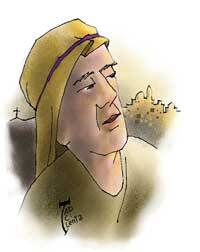The Face of Freedom
A missionary friend working in a country where many forms of violence are a part of the fabric of everyday life remarked to me recently that she was very conscious that she can choose whether to stay or leave. This is a choice that the people to whom she has dedicated her life do not have. Some friends and family members do not understand how she could choose to put her own life in danger for the sake of the people she has come to love as her own.
Such a choice faces Jesus in today’s Gospel. In Luke’s version of this story, which we hear every year on the second Sunday of Lent, there are unique details that point to an earlier source that tells us more clearly what really happened at the transfiguration.
The episode is set at an important turning point in the Gospel. Jesus has been teaching, preaching, healing, exorcising demons and gathering disciples as he traverses Galilee. But soon he will “set his face to go to Jerusalem” (9:51). Something happens on the mountaintop that helps Jesus to know what is his next step in his mission. Luke alone notes that when Jesus goes up the mountain with Peter, James and John, his purpose is to pray.
A clue to the nature of Jesus’ prayer comes in the content of the conversation among Jesus, Moses and Elijah. They “spoke of his exodus that he was going to accomplish in Jerusalem.” Jesus is wrestling with the decision whether he should leave Galilee and direct his efforts toward Jerusalem, the center of religious and political power. There is still much to do in Galilee, and he could continue to minister there, but he struggles to know whether his efforts could bring about greater systemic change if he were to go to Jerusalem.
But Jesus is no fool. The handwriting is on the wall. Opposition to him is already mounting, and it would only intensify if he were to go to Jerusalem. As at every major turning point in the Gospel, Jesus enters into deep communion with God as he discerns what to do.
In this profound encounter with God, Jesus receives surety about his next steps, and this “aha” experience is visible on his face. Notably, Luke does not say that Jesus was transfigured; rather, that “his face changed in appearance.” Like Moses, whose face was radiant after being with God on Mount Sinai (Ex 34:29), and Hannah, whose face was lifted up after her prayer was heard (1 Sm 1:18), so Jesus’ encounter with God is written on his face. He comes to understand that indeed, he is to go to Jerusalem and that he will be put to death there, but his death will not be the end of his life and mission. Rather, his exit from earthly life will bring the new liberation for God’s people. The Greek word exodos (9:31) literally means “exit,” connoting “death” (2 Pt 1:15), and also evokes the liberation of the Israelites from slavery.
During this intense prayer of discernment, Jesus is given sure signs that he is guided by God in his choice. A cloud, the sign of God’s presence with the Israelites as they went forth from Egypt, overshadows him as at his baptism. Two heavenly messengers embody the divine presence, giving Jesus strength as he leans on God’s word in the law and the prophets. The heavenly voice reassures both him and his disciples of Jesus’ chosen status and the rightness of his choice. Thus assured of God’s love and direction, Jesus turns his transformed face toward Jerusalem.
Placing his own life in danger, Jesus makes a deliberate, prophetic choice to continue to “proclaim release to the captives” (4:18), as he had declared in his hometown synagogue. His death is not an inevitable fate but a choice for freeing love.
This article also appeared in print, under the headline “The Face of Freedom,” in the February 22, 2010, issue.








